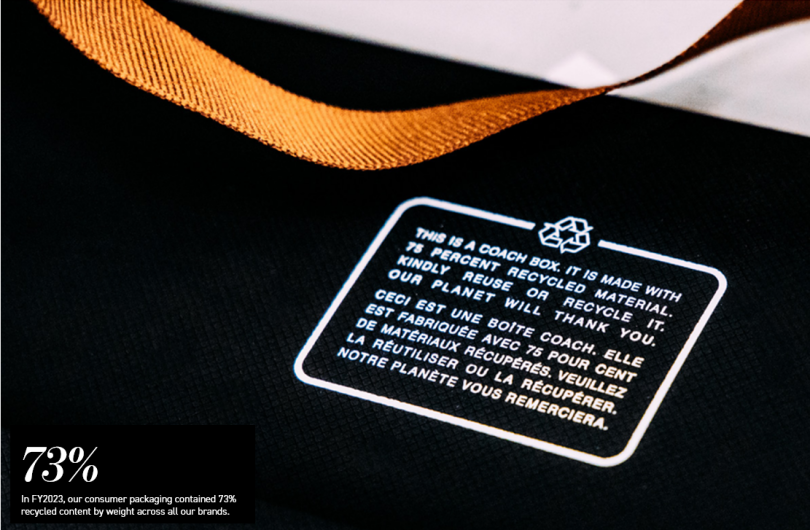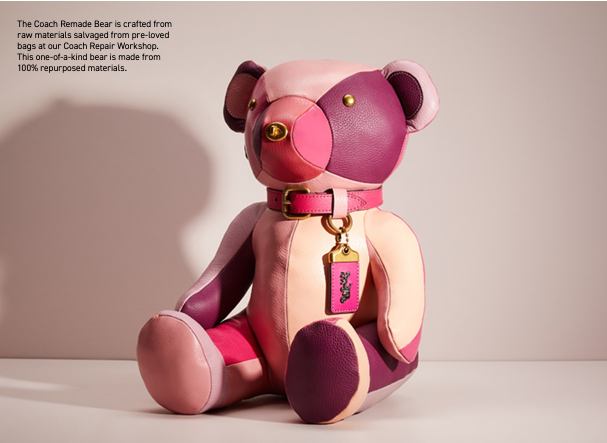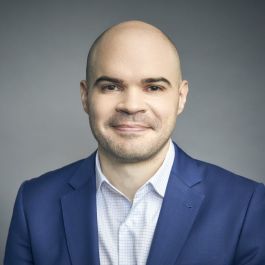Imagine for a moment that you’re facing down your closet and getting ready to leave the house. Whether you’re choosing a bag that will fit your laptop en route to the office or the right boots for a snowy evening out, there’s never just one concern in mind.
Each choice possesses multiple facets: Does it fit your personal style? Does it suit the occasion, the weather and the needs of your day?
At Tapestry, these considerations are foundational to each item created by the Coach and Kate Spade New York brands. But there’s another core tenet to consider: sustainability.
“We use what we call the SPI framework for making these decisions — Style, Performance, Impact,” said Jessie Wasser. “We look at three things: Is this product beautiful and something that consumers would be interested in? Is it durable, and does it have the quality our customers expect from us? What is the environmental impact of our products, and can we make choices that will have less of an impact?”
“Is this product beautiful? Is it durable? And can we make choices that will have less of an environmental impact?”
Wasser, Tapestry’s manager of sustainability within the environmental social governance team, spends her time considering that third question — whether writing Tapestry’s annual corporate responsibility report or digging into initiatives focused on zero waste initiatives, reducing greenhouse gas emissions and water use across Tapestry’s stores and fulfillment centers.

Tapestry aims to achieve zero waste at its North American corporate sites, meaning it aims to divert from landfills at least 90 percent of waste generated, instead finding opportunities for recycling, composting or reuse. Recently, Coach’s New Jersey workshop achieved Gold-level TRUE zero waste certification from the U.S. Green Building Council. Aptly, this site houses the Coach (Re)Loved & Repair Workshop, a circular ecosystem for refurbishing, reimagining and recycling pre-loved and damaged Coach products.
Within the Coach (Re)Loved & Repair Workshop team, a group of employees have taken on responsibilities as “zero waste ambassadors” in addition to their full-time roles. These ambassadors are site experts, who know where every piece of material should go, down to the whisp of leftover thread that remains after fixing a handbag.
“At the Coach (Re)Loved & Repair Workshop, our zero waste ambassadors are already dealing with routing products away from landfills in their day-to-day jobs,” Wasser noted. “As one of their core responsibilities, they are looking at products that may be unsellable or damaged and finding ways to make sure they stay out of landfills.”
“People were coming to us with ideas for items as specific as single-use coffee pods,” Wasser continued. “Sustainability is ingrained in our team at the Coach (Re)Loved & Repair Workshop, so for Tapestry, it’s been about making sure they have the resources and means to continue supporting sustainability programs they’re passionate about.”

Good for the Earth and Good for the Business
When Kevin Bonney, now senior director of financial planning and analysis at Tapestry, received a Coach leather work bag as a graduation gift, he couldn’t have known it would spark a journey toward sustainability within the company's global supply chain. Bonney also didn’t expect that his time with Tapestry would take him deep into integrating sustainability practices across the company’s operations — from factory production to product delivery.
While Bonney’s role focuses on financial forecasting and impact assessment of Tapestry's supply chain, he also works to reduce the environmental footprint of Tapestry’s operations, particularly at its fulfillment centers and within production processes. This involves maximizing material utilization during the production process and streamlining transportation routes, pushing fulfillment centers closer to zero waste certification, as well as larger investments like Tapestry’s recent stake in sustainably recycled-leather company Gen Phoenix.
As Tapestry’s teams work to get products to customers, each element of the process is an opportunity to enhance sustainability practices.
“Every single point of the process is examined and optimized,” Bonney said.
That focus is tangible in the company’s packaging practices, where the priority is balanced between product protection and reducing materials. By challenging the necessity of excessive packaging materials, the company aims to minimize waste, while ensuring products reach customers undamaged.
Less visible is Tapestry’s shift away from using air freight toward less resource-intensive transportation options like large ocean carriers. Beyond the physical infrastructure, part of Bonney’s role is looking for opportunities where Tapestry can invest as a first-mover rather than waiting for the market to catch up with scalable solutions.
“Excellence and innovation are part of Tapestry’s DNA, so we are always looking for areas where we can invest in those development processes early on,” Bonney said. “We know the costs will always be higher at the beginning, but when we can drive innovation in these spaces, we can be part of the solution to making the environmentally correct choice a cost-effective option.”
“We know the costs will always be higher at the beginning, but when we can drive innovation in these spaces, we can be part of the solution to making the environmentally correct choice a cost-effective option.”
The company has also invested in solutions for sourcing environmentally preferred materials like Generation Phoenix, a company specializing in creating materials with recycled leather fibers. This initiative repurposes leather scraps destined for landfill and fosters a culture of innovation in sustainable materials development.
Tapestry encourages informed decision-making when developing products by working with design teams to align its sustainability targets with design choices. From a production standpoint, the company also prioritizes maximizing material utilization as a means of minimizing waste. This involves meticulous attention to detail, such as optimizing cuts to ensure minimal material loss while maintaining product quality.
By marrying financial prudence with environmental stewardship, Tapestry exemplifies how companies can drive positive change while remaining commercially viable. As Bonney aptly put it, sustainability and profitability are not mutually exclusive — they are mutually reinforcing.

Influencing Change Beyond Tapestry’s Walls
Tapestry’s sustainability work is more than just geographically far-reaching. With The Tapestry Foundation, the company also invests in sustainability efforts that will influence change far beyond its business operations.
When Jordan Catalana joined Tapestry as the manager of social impact and the Tapestry Foundation, she was drawn to the company’s approach to sustainability that brought together her experiences in corporate social responsibility and environmental, social and governance initiatives within the apparel and accessories industry.
One of the cornerstone initiatives of Tapestry's sustainability efforts is its partnership with the World Wildlife Fund, aimed at combating deforestation and habitat conversion in the leather industry. This groundbreaking program exemplifies Tapestry's commitment to tackling complex ecological issues — even where direct business involvement may not be immediately apparent.
“The work on the ground in Brazil is to combat deforestation through advancements in the leather supply chain,” Catalana explained. “It's an ecological opportunity that needs to be invested in, and we're able to do that.”
As Tapestry progresses through the midway point of its partnership with WWF, tangible outcomes are beginning to emerge, showcasing the efficacy of collaborative, long-term sustainability initiatives. Catalana outlines the multifaceted approach adopted by Tapestry: reforestation efforts, pioneering pilot programs aimed at transforming agricultural practices and beyond. Through these initiatives, Tapestry mitigates its environmental footprint and catalyzes broader industry-wide change.
“We're focused on reforesting cleared land — planting trees and supporting local indigenous communities to rebuild this land back themselves and create sustainable agriculture systems and farms,” she said. “And then we're testing various pilots, such as tagging cows to trace their migration patterns and working with farmers on different incentive programs to improve their actions.”
Integral to Tapestry's sustainability ethos is its recognition of the interconnectedness of its value chain — from material sourcing to end-user consumption. Catalana underscored the importance of engaging stakeholders at every stage of this journey, including customers, suppliers and local communities. By leveraging the collective resources of its various brands and foundations, Tapestry endeavors to foster healthier, more sustainable communities worldwide.
“While we are investing in long-term, industry-wide solutions, we also realize sustainability is important here and now, and we want to support our people through some of those challenges,” Catalana said.
The launch of the Tapestry Associate Relief Fund underscores the company's dedication to support its employees amidst challenges posed by unexpected natural or humanitarian disasters. By providing financial assistance during times of hardship, Tapestry demonstrates its commitment to the well-being of its global workforce, acknowledging the intersecting vulnerabilities exacerbated by environmental disruptions.
Reflecting on Tapestry's sustainability journey, Bonney emphasized the company's unwavering commitment to driving meaningful change. From financial investments to cultural integration, Tapestry's sustainability initiatives permeate every facet of its operations.
“Our people live and breathe sustainability,” he said. “The company has made it a financial and cultural priority for all of us. My first years with this company a decade ago didn’t have a lot of connection to sustainability, but now it is woven into every part of my work. For us, that’s the commitment.”
“Our people live and breathe sustainability. For us, that’s the commitment.”








